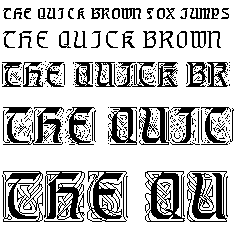
What distinguishes a great TrueType font?
Apart from the design of the font itself, there are two key marks of font quality: the character outlines and the hinting. Respectable font foundries generally produce accurate and efficient outlines. But only a few foundries currently produce fonts with hinting that exploits TrueType's potential to the full.Now although there are applications, such as DTP Type Designer and FontLab 3.0, which do a reasonable job of converting the hinting in an existing Type 1 font into TrueType instructions, the best programs (and TrueType hinting instructions are programs) are always written by hand rather than automatically generated. There is a small number of experienced font engineers able to write TrueType code that is significantly better than the format converters or the "auto-hinters".
And where do you get them?
- Monotype Typography
Monotype created the superbly hinted core fonts for Windows. Free, updated versions of Times New Roman, Arial, Courier and Impact are available from Microsoft's web site. These fonts contain the WGL4 character set, which handles all major European languages, west and east.
Monotype produces a growing range of particularly well hinted TrueTypes, honoured with the 'ESQ' label. See their page: Enhanced Screen Quality Fonts. - Microsoft
As well as supplying the free Monotype fonts above, Microsoft have commissioned the following designs, now available freely on the web. All have excellent hinting. Microsoft use Visual TrueType, a system of programming the most important TrueType instructions with a graphical user interface (based on the TypeMan program from Type Solutions).
- Verdana is Matthew Carter's latest sans-serif, hinted by Monotype ace Tom Rickner. It's highly suitable for use on screen. Comes in the usual 4 styles.
- Georgia is an elegant serif face, also by Matthew Carter. 4 styles.
- Trebuchet is a friendly sans-serif from Vincent Connare. 4 styles.
- Comic Sans is a casual design by Vincent Connare that originated in a font project for the 3D Home Designer program. It's very different from Adobe Tekton. Regular & bold.
- Apple
Apple created the core TrueTypes for the Mac, including Linotype's Times Roman and Helvetica. These were historically important fonts, as they had to prove TrueType against Type 1/ATM and other competing font technologies. At that time, Apple and Microsoft were aiming to become independent of Adobe for fonts and printing technology. Apple developed the font strategy, TrueType, while Microsoft worked on the printing side, the now forgotten PostScript clone, TrueImage. Apple and Microsoft cross-licensed each other their technologies; it wasn't so easy then to see who had the better deal...
Apple have also commissioned some excellent TrueType GX fonts including Hoefler Text, Skia and Apple Chancery. - Linotype
Linotype offer excellent TrueType versions of many of their famous fonts, including Times, Helvetica and Palatino. They are also one of the few foundries producing GX fonts, and - since much of this work can be re-used - will be releasing OpenType fonts soon too.
Microsoft will soon release the huge OpenType implementation of Linotype Palatino after hinting it, and having Hermann Zapf design many new characters and approve the work. This marks a welcome return to favour for Microsoft, after distributing Monotype's Palatino knock-off "Book Antiqua" for years. - Font Bureau
The Font Bureau in Boston makes some of the best TrueTypes around, their hinters delighting in pushing the hinting language to the limits. Some of the fonts in Microsoft's (discontinued) TrueType Font Packs were digitized and hinted by the Font Bureau. One of these, Augsburger Initials, has some of the most powerful TrueType hinting yet seen, removing the fine details at low resolution [Figure 1]. Skia, one of a handful of extant GX fonts with variations (a multiple master technology), is also theirs.
Advanced hinting in Augsburger Initials
The hinting program checks the number of pixels available to display the character: if that's below a certain threshold, the program collapses the fine detail so it does not display; at large sizes detail is left alone.
[Fig. 1] - Adobe
Pundits swore it would never happen, but in October 1997 Adobe bit the bullet and released a series of manually hinted TrueType fonts, known as Adobe WebType. This is part of the process of burying of the hatchet with Microsoft, in which OpenType is apparently ending the "font wars"; it constitutes a major volte-face by the corporation, which is hereby allowing its fonts to be embedded in web pages, and implicitly admits that Type 1 would not have been up to the job in terms of screen quality. The 12 fonts in the WebType pack are Minion, Myriad, Caflisch Script, Mezz, Penumbra and Giddyup - and variations thereof. Minion Web is now distributed free with Internet Explorer 4. - Agfa
Agfa have created well hinted TrueType versions of a small selection of their large Type 1 range. TrueType packs were available, such as the "Discovery" pack (magnetic compass included!), and the "HP Font Pack" of TrueTypes matching the fonts in the HP LaserJet 4 printer. - Bitstream
Their entire range of over 1000 fonts is available in both TrueType and Type 1 flavours. Although the TrueTypes are generally no better at low resolutions than their Type 1s counterparts, at least they're no worse - like some foundries.
Bitstream's Cyberbit font, a Univers-like design with over 8500 characters, has been made available for free. It's been well hinted at just one screen size; if you want any other sizes well hinted, you are invited to pay for it. - TYPE*chimérique
TYPE*chimérique, creators of this website, can add expert manual hinting to any TrueType font. We can also convert your Type 1 fonts and optimize them for on-screen viewing with TrueType. See our expert hinting page.
TYPE*chimérique | TrueType Typography | TYPE*links